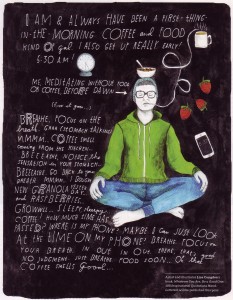Unwise Attention
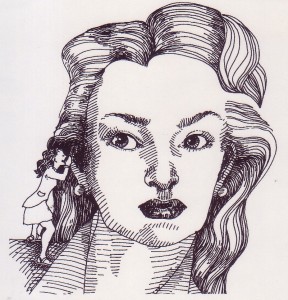 In some ways, we didn’t “get very far” in our discussion last night of Joseph Goldstein’s new book, Mindfulness: A Practical Guide to Awakening, because we started…and ended…on page 17, where the Buddha is quoted as saying, “whatever we frequently think of and ponder, that will become the inclination of our minds.”
In some ways, we didn’t “get very far” in our discussion last night of Joseph Goldstein’s new book, Mindfulness: A Practical Guide to Awakening, because we started…and ended…on page 17, where the Buddha is quoted as saying, “whatever we frequently think of and ponder, that will become the inclination of our minds.”
But though we didn’t get “far” in terms of pages, I think we went a long way in terms of practice, because we spent most of the time talking about what all this means about what we should do….in our daily life, with relationships, work situations, conflicts and struggles. Especially when there are people and things that really piss us off!
The discussion brought to mind something I had just read in Bhikkhu Analayo’s excellent (but formidably titled): Excursions into the Thought-World of the Pali Discourses.
Here’s what Analayo says, quoting directly from the Buddha’s teachings:
A prominent cause of the arising of ill-will is unwise attention to the sign of irritation (AN I 3). [By “sign of irritation” he means whatever it is that we get pissed off about.] Once ill-will has arisen, the mind tends to return again and again to the particular sign, event or person that has occasioned the arising of ill-will.
As to what to do about it:
Intentional relaxation can have substantial results if applied directly to the mind itself. The point here is that ill-will inevitably involves a narrow perspective, usually a focusing on the irritating and displeasing aspect of a situation or a person at the exclusion of other aspects that do not reinforce irritation….A conscious broadening of the scope of perception can go a long way in undermining the foundations of ill-will.
So in plain English:
Don’t spend so much energy thinking about whatever it is that’s pissing us off. Recognize it, yes, but then expand the focus of attention to include things about the person or situation that do NOT piss us off!
***
(illustration by George Willett, from Roger von Oech’s Creative Whack Pack)
Spend the Day with Jack
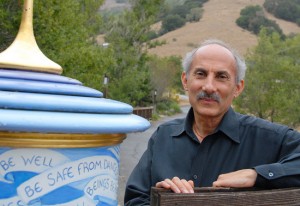 Jack Kornfield will be leading a daylong meditation retreat at Spirit Rock on Sunday, April 6….but you don’t have to fly to California to attend! (And even if you did, you wouldn’t be able to get in, because now it’s SOLD OUT.)
Jack Kornfield will be leading a daylong meditation retreat at Spirit Rock on Sunday, April 6….but you don’t have to fly to California to attend! (And even if you did, you wouldn’t be able to get in, because now it’s SOLD OUT.)
The whole day will be offered as a LIVE video stream, 11:00 am to 7:00 pm (St. Louis time), which you can attend by registering here.
And if you’re busy on the day of the event…..no problem! If you register before the daylong begins, you will have access to the recorded event for 90 days. Cost is $30.
This is a traditional Insight Meditation (vipassana) daylong retreat that will include systematic instructions, silent sitting and walking meditation, and a dharma talk, suitable for both beginning and experienced meditators. It’s a great opportunity to sit and walk and listen to Jack.
Don’t miss it!
A Peek at a Retreat
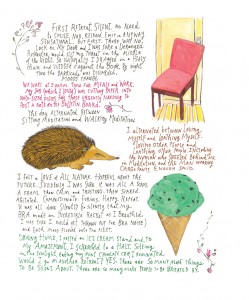 Last year, artist Maira Kalman sat her first ever silent retreat at IMS (Insight Meditation Society, in Barre, MA) and produced a series of illustrations about her experience, which appeared over several months in Mindful Magazine.
Last year, artist Maira Kalman sat her first ever silent retreat at IMS (Insight Meditation Society, in Barre, MA) and produced a series of illustrations about her experience, which appeared over several months in Mindful Magazine.
Here’s the first installment. (Click on the image to enlarge.)
Wake Up!
 I was in kind of a fog today and just couldn’t think of what I wanted to post. So I stood in front of my bookshelf for a while until I found myself picking up one of the books, then I just sort of let it fall open….to see if something might present itself.
I was in kind of a fog today and just couldn’t think of what I wanted to post. So I stood in front of my bookshelf for a while until I found myself picking up one of the books, then I just sort of let it fall open….to see if something might present itself.
The book turned out to be Comfortable with Uncertainty: 108 Teachings, by Pema Chodron
Here’s the page it opened up to:
#20: “All activities should be done with one intention.”
Breathing in, breathing out, feeling resentful, feeling happy, being able to drop it, not being able to drop it, eating our food, brushing our teeth, walking, sitting–whatever we’re doing could be done with one intention. That intention is that we want to wake up, we want to ripen our compassion, we want to ripen our ability to let go, we want to realize our connection with all beings. Everything in our lives has the potential to wake us up or to put us to sleep. Allowing it to awaken us is up to us.
***
I post this today with the intention to wake up!
May it be so.
What It’s Like
Mindful magazine asked artist Lisa Congdon to meditate for 15 minutes and to illustrate her experience. Here’s what it was like for her. Sound familiar?
(Click on the image to see it full size. Or check out the April issue of Mindful magazine. It’s on the back page.)
Mindful Snacking
Another installment from DharmaTown Kitchen:
1 cup almonds or mixed raw nuts
1 Tbsp vegetable oil
1 tsp finely ground espresso
1 tsp garlic powder
1 tsp salt
1 tsp ground nutmeg
Pinch of cayenne pepper
Preheat oven to 350 degrees (F). In a small bowl, toss nuts in oil, then place on a baking sheet. Roast in oven for 8 to 10 minutes, or until lightly toasted. In a medium bowl, combine all the remaining ingredients, then add nuts and toss until lightly coated. Return nuts to baking sheet and toast for 2 more minutes. Serve warm or at room temperature.
(image and recipe from Espresso: Culture & Cuisine by Karl Petzke and Sara Slavin)
What’s Not There
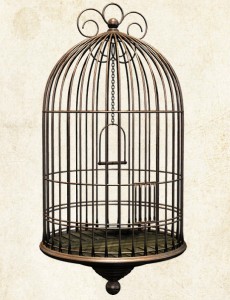 Last night I listened (for the second time) to a wonderful talk by Phillip Moffitt, given at the end of the month-long retreat held this past February at Spirit Rock. The talk is called Liberation Now Leads to Full Liberating Awareness and in it, Phillip uses poetry (as well as examples from his own practice) to convey a sense of what all these teachers/sages/poets are talking about when they use words like “liberation.” (click here to listen to the talk)
Last night I listened (for the second time) to a wonderful talk by Phillip Moffitt, given at the end of the month-long retreat held this past February at Spirit Rock. The talk is called Liberation Now Leads to Full Liberating Awareness and in it, Phillip uses poetry (as well as examples from his own practice) to convey a sense of what all these teachers/sages/poets are talking about when they use words like “liberation.” (click here to listen to the talk)
Here is one of the poems from the talk that really spoke to me. It’s called What’s Not Here, by Rumi.
I start out on this road,
call it love or emptiness,
I only know what’s not here.
Resentment seeds, backscratching greed,
worrying about outcomes, fear of people.
When a bird gets free,
it does not go for remnants left on the bottom of the cage.
Close by, I’m rain. Far off,
a cloud of fire. I seem restless,
but I am deeply at ease.
Branches tremble. The roots are still.
I am a universe in a handful of dirt,
whole when totally demolished.
Talk about choices does not apply to me.
While intelligence considers options,
I am somewhere lost in the wind.
The Best Season
Since today is the first full day of spring, I offer this poem by Wu-Mein:
 Ten thousand flowers in spring, the moon in autumn,
Ten thousand flowers in spring, the moon in autumn,
a cool breeze in summer, snow in winter.
If your mind isn’t clouded by unnecessary things,
this is the best season of your life.
(illustration from: I Told You So, by Daisy de Villeneuve)
Mindful Morning
 Want to get off to a good start? Try this practice from Emotional Chaos to Clarity, by Phillip Moffitt:
Want to get off to a good start? Try this practice from Emotional Chaos to Clarity, by Phillip Moffitt:
“The practice of starting your day with clarity begins with becoming mindful of what’s true in your body and your mind when you awaken. So while you’re still lying in bed, notice if you feel rested or if you’re still tired. Is your body tense or at ease? What parts of your body are relaxed?
“Next observe your mind and notice whether it is relaxed or tense, quiet or busy. What is it doing? Is it resting, planning, complaining, rehearsing, or remembering a dream? Is it fuzzy or clear? Is it experiencing an emotion such as excitement, dread, or fear? You now know what needs your attention.
“The next step is to use your body or your mind state as an object of contemplation…Maybe you don’t feel rested, or you feel rested but parts of your body are tense, or when you think about your day parts of your body tense up…
“In response to whatever you discover to be true in your body, continue to lie in bed and do a body scan. In a body scan you progressively tense and relax each part of your body as you imagine healing energy moving through it…
“Once you’ve completed your body scan, which can take as little as five minutes or as much as half an hour, turn your attention to what’s going on in your mind…. Is there underlying tension? Is it racing? Jumpy? If so, invite the mind to relax. You can evoke this feeling of relaxation in a number of ways: focus on a soothing memory or image, reflect on something you”re grateful for, or do loving-kindness practice in your mind [send wishes of well-being to those you love]…
“After relaxing your body and mind as best you’re able, the next step in starting your day is to contemplate what lies ahead. First picture the day in your mind. Observe your attitude….When you focus on something that’s difficult or requires a lot of attention, pause, breathe, and allow your body and mind to relax.
“Repeat this process of imagining, noticing, and relaxing until you feel centered. This feeling of centeredness becomes your reference point when you’re actually engaged in the difficult activities you imagined.”
In Plain English: FREE!
 I had a very nice conversation yesterday, by Skype, with a long-lost friend (well, not exactly lost, but someone I haven’t heard from in several years), who, as it turns out, has recently gotten interested in Mindfulness meditation! He asked me to recommend a book on the subject and I suggested Mindfulness in Plain English, by Bhante Gunaratana, because, as I said to him, it’s very clearly written, very straightforward, and also very profound.
I had a very nice conversation yesterday, by Skype, with a long-lost friend (well, not exactly lost, but someone I haven’t heard from in several years), who, as it turns out, has recently gotten interested in Mindfulness meditation! He asked me to recommend a book on the subject and I suggested Mindfulness in Plain English, by Bhante Gunaratana, because, as I said to him, it’s very clearly written, very straightforward, and also very profound.
I told him not to be put off by the fact that the author is a Sri Lankan monk. It’s not a religious book. But it’s also not a trendy, self-help therapy book and it’s definitely not a bunch of new-agey fluff. It doesn’t pull any punches or dumb anything down. But at the same time, it’s very easy to read and very accessible. (The title says it all.)
And he told me that it’s now available for FREE on iBooks! (Thanks, Eric!)
I have recommended this book many, many times in the past, and even given it away as gifts. I think it was the first book I ever read on Mindfulness that really made sense to me.
And now it’s FREE! (If you don’t have access to iBooks, just search around on the internet. I’m sure you’ll find it. And if not…there’s always the library.)
Here’s a sample, from the first chapter, titled Meditation: Why Bother?
“Meditation is not easy. It takes time and it takes energy. It also takes grit, determination, and disciple. It requires a host of personal qualities that we normally regard as unpleasant and like to avoid whenever possible. We can sum up all of these qualities in the American word gumption. Meditation takes gumption. It is certainly a great deal easier just to sit back and watch television. So why bother? Why waste all that time and energy when you could be out enjoying yourself?
“Why? Simple. Because you are human. Just because of the simple fact that you are human, you find yourself heir to an inherent unsatisfactoriness in life that simply will not go away. You can suppress it from your awareness for a time; you can distract yourself for hours on end, but it always comes back, and usually when you least expect it. All of a sudden, seemingly out of the blue, you sit up, take stock, and realize your actual situation in life.”
***
Got gumption? Give yourself the gift of this book.
And if you already have it, go get it off the shelf and read it again.
It’s worth it.

